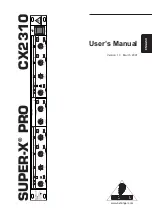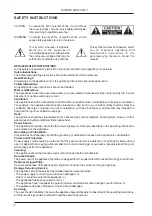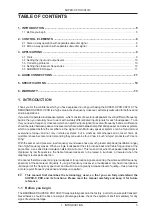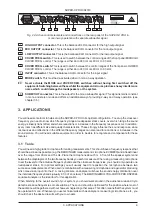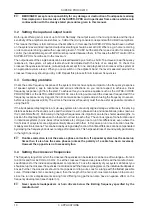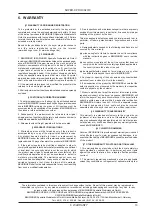
10
SUPER-X PRO CX2310
3. APPLICATIONS
+
BEHRINGER accepts no responsibility for any damage or destruction of loudspeakers arising
from improper or incorrect use of the SUPER-X PRO and in particular from actions which are in
contravention with the clearly stated procedures given in this manual.
3.2 Setting the input and output levels
Both inputs offer a gain or loss of up to 12 dB. Normally, the output level on the mixing console and the input
sensitivity of the amplifiers are identical, i.e. 0 dB at the mixing console corresponds with 0 dB at the amplifiers.
This means that there is full control over the amplifiers. In this case the SUPER-X PRO should have no effect
on the system level and all input and output level settings should be set at 0 dB. Where e.g. a home recording
or disco console is being used with an operating level of -10 dBV but the amplifiers need +4 dBu for complete
control, then an additional gain of 12 dB must be provided between them. In this case the INPUT control of the
SUPER-X PRO should be set to the maximum.
The output levels of the single bands can be raised/lowered by as much as 6 dB. To achieve a linear frequency
response in the system, all output levels should be adjusted with the help of an analyzer. To check the
crossover frequencies and levels, mute all outputs except for one, and play back pink noise over the system at
an appropriate volume level. When you now switch on the adjacent band, the level measured around the
crossover frequency should go up by 3 dB. Repeat this process for all crossover frequencies.
3.3 Correcting problems
Check the entire frequency response of the system. Rooms have quite an impact on the frequency response
of speaker systems, due to resonance and various reflections, so you cannot expect to achieve a linear
frequency response right from the start. To achieve this, you need an equalizer such as the ULTRA-CURVE
PRO DSP8024 or the ULTRA-GRAPH GEQ3102. Look for drop-outs around the crossover frequencies! If the
frequency response is very irregular, then it can make sense to grade adjust it using the frequency crossover,
before using an equalizer (EQ). The errors in the crossover frequency must then be as far as possible corrected
using the EQ.
If the loudspeaker diaphragms in a multi-way system are not exactly aligned along a vertical axis, the varying
distances between the sound source and the listener result in phase errors and cancellations (also known as
the comb filter effect). Particularly in the higher frequencies it is important, due to the shorter wavelengths, to
position the diaphragms above each other and not next to each other. The various types of construction used
in individual systems (horns, bass reflex cabinets etc.) still give rise to run time differences, even where the
front sides of all systems are aligned vertically above each other. In this case a run time correction must be
made by electronic means. This can be done by using a delay function. Run time differences can be compensated
by delaying the frequency bands over a range of milliseconds. This helps avoid loss of sound quality, particularly
in the high tone ranges.
+
Runtime correction is not the same as phase correction. If a speaker system has the same run
times then it also has the same phases (unless the polarity of a cable has been reversed).
However the opposite is not necessarily true.
3.4 Setting the crossover frequencies
The frequency range from which the crossover frequencies can be selected, can be one of two rangesfrom 44
to 930 Hz and from 440 Hz to 9.3 kHz. To set the crossover frequencies, please first read the manufacturers
specifications for the individual loudspeaker components. To use the capacity of your system at its best you
should set up the crossover frequencies in accordance with the frequency diagrams on the individual loudspeaker
boxes. Further, the crossovers should not lie on peaks or drop-outs. Look for a range with the flattest possible
curve. If folded bass horns are being used, then the length of the horn path must also be taken into account,
since the run time displacements arising from differing long paths can also have a negative effect on the
frequency development (see chapter 3.3).
+
Never operate loudspeakers or horn drivers below the limiting frequency specified by the
manufacturer!

